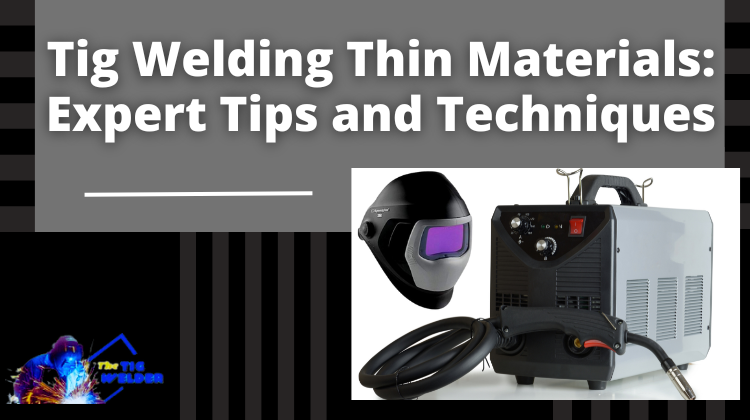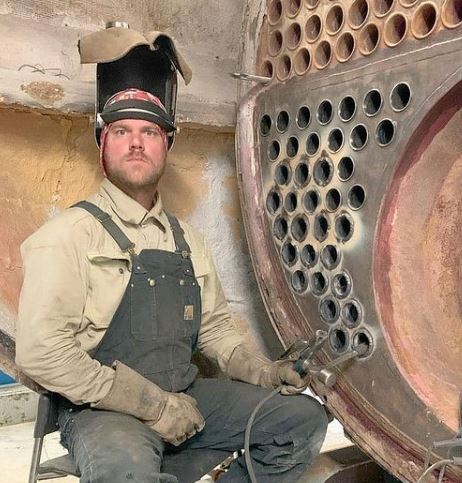A tig weld is produced by heating a tungsten electrode with a gas that acts as a welding electrode. Industries like aerospace, automotive, and heavy machinery manufacturers often use this highly precise and versatile method.
Thin materials, such as sheet metal or thin-walled tubing, present unique challenges when tig welding due to their thinness and sensitivity to heat. Welding thin materials require high precision and control to avoid warping or melting through the material.

Expert Tips And Techniques For Tig Welding Thin Materials
Welding thin materials can be tricky, as the high heat of the welding process can distort or burn through the material. Tig welding is popular for thin materials because it allows for precise heat control and lower heat settings. This guide will provide expert tips and techniques for tig welding thin materials, including choosing the right filler metal, adjusting the heat and current settings, and using techniques such as pulse welding and backstep welding. You can achieve strong, successful welds on even the thinnest materials with the right approach.
Use A Smaller Tungsten Electrode
A smaller tungsten electrode can help reduce the heat input and minimize the risk of warping or melting through the material. A smaller electrode will also be more precise and easier to control, which is important when welding thin materials.
Lower The Amperage
Lowering the amperage can also reduce the heat input and minimize the risk of warping or melting through the material. Finding the right balance between amperage and heat input is important to achieve a high-quality weld without damaging the material.
Increase The Gas Flow Rate
Increasing the gas flow rate can help shield the weld from oxygen and other contaminants, which can lead to porosity and other defects. A higher gas flow rate can also help dissipate heat and prevent warping or melting through the material.
Use A Shorter Arc Length
Maintaining a shorter arc length can reduce the heat input and improve the precision of the weld. Finding the right balance between arc length and heat input is important to achieve a high-quality weld without damaging the material.
Use A Foot Pedal Or Thumb Control
Using a foot pedal or thumb control can give the welder precise control over the heat input, allowing them to adjust the amperage on the fly and fine-tune the weld as needed. This can be especially useful when welding thin materials, as it allows the welder to react quickly to any changes in the material or the weld puddle.
Practice Proper Technique
Proper technique is crucial when welding thin materials to achieve a high-quality weld without damaging the material. This includes maintaining a consistent arc length, controlling the weld puddle, and using the right amount of heat input. Keeping the tungsten electrode clean and properly shaped is also important to ensure a stable arc.
Challenges Of Tig Welding Thin Materials
Difficulty in maintaining a stable arc: Tig welding thin materials can be difficult due to their thinness and sensitivity to heat. A stable arc is crucial for producing a high-quality weld, and any fluctuations in the arc can lead to porosity or other defects.
Risk of warping or melting through the material: One of the main challenges of welding thin materials is the risk of warping or melting through the material due to the high heat input required. This can be especially problematic when welding thin sheets or tubes, as the material may not be able to withstand the heat and may deform or even melt completely.
Need for precise control of heat input: Precise control of heat input is crucial when tig welding thin materials to avoid warping or melting through the material. Too much heat can cause the material to deform or melt, while too little heat can result in incomplete fusion or other defects.
FAQ’s
How Do You Weld Thin Metal With Tig?
To weld thin metal with TIG, follow these steps:
- Clean the metal: Use a grinder or wire brush to remove any dirt, rust, or paint from the metal.
- Set up the TIG machine: Set the amperage and gas flow rate according to the thickness of the metal you are welding.
- Clamp the metal: Use C-clamps or magnets to hold the metal in place and prevent it from moving during welding.
- Strike an arc: Hold the TIG torch at a slight angle to the metal and strike an arc by touching the tungsten electrode to the metal and then pulling it away slightly.
- Weld: Slowly move the torch along the joint, adding filler metal as needed. Keep the arc length consistent and maintain a steady speed to avoid overheating the metal.
Is Tig Welding Good For Thin Metal?
TIG welding is a good choice for welding thin metal because it produces a clean, high-quality weld with minimal distortion. TIG welding is also a good choice for welding thin metal because it allows the welder to have more control over the weld puddle, which can help prevent overheating and warping.
How Do You Tig Weld Perfectly?
To TIG weld perfectly, follow these steps:
- Practice: As with any skill, practice is key to achieving perfection in TIG welding. Spend time practicing on scrap metal to develop your technique and get a feel for the process.
- Use the right equipment: Ensure you have the right equipment, including a clean TIG torch, good-quality filler metal, and a reliable power supply.
- Set the right amperage: Set the amperage according to the thickness of the metal you are welding to avoid overheating and warping.
- Maintain a consistent arc length: Keep the arc length consistent with maintaining a stable weld puddle and producing a smooth, even weld.
- Use the right filler metal: Choose a filler metal compatible with the base metal you are welding to ensure a strong, durable weld.
How Do You Weld Thin Metal Without Warping?
To weld thin metal without warping, follow these steps:
- Preheat the metal: Preheating the metal before welding can help reduce the risk of warping by reducing the difference in temperature between the weld and the base metal.
- Use a low-heat welding process: TIG welding is a low-heat welding process that is less likely to cause warping than other welding methods, such as MIG welding.
- Clamp the metal: Use C-clamps or magnets to hold the metal in place and prevent it from moving during welding.
- Weld slowly: Weld slowly to avoid overheating the metal and causing warping.
- Allow the metal to cool slowly: After welding, cover the welded area with a heat-resistant material to allow it to cool slowly and reduce the risk of warping.
What Type Of Weld Is Generally Used For Thin Metals?
TIG welding is generally used for thin metals because it produces a clean, high-quality weld with minimal distortion. TIG welding is a good choice for thin metals because it gives the welder more control over the weld puddle, which can help prevent overheating and warping. Other welding methods, such as MIG welding, may cause warping in thin metals due to the higher heat levels.
Conclusion
Tig welding thin materials requires high precision and control to avoid warping or melting through the material. By following expert tips and techniques, such as using a smaller tungsten electrode and controlling the heat input, achieving successful and high-quality welds on thin materials is possible. It is important to carefully plan and prepare for the welding process and to follow proper techniques to ensure the best possible.

It’s been years since I got into welding as a side hustle. It’s been so long since Doing All kinds of welds for business and pleasure as this is my hobby. Being in this field I have learned from hands-on-experience also came to know what gears work and what doesn’t. The Tig Welder is my own platform where I use to share my experience.






Leave a Reply